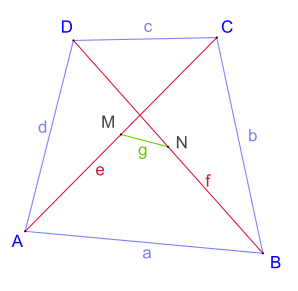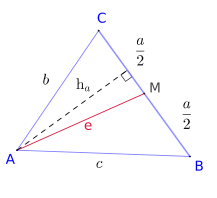Euler's theorem (quadrangular geometry)
The set of Euler the quadrilateral geometry is a geometric theorem , the fundamental identity equation on the relationship between the side lengths of a square and the length of its two diagonals indicates. The theorem is one of the many contributions made by the great Swiss mathematician Leonhard Euler to elementary geometry .
Formulation of the sentence
The sentence is as follows:
- A convex quadrilateral of the Euclidean plane is given .
- On the two diagonals and are respectively the two center points .
-
Then:
- or
- .
Inference
The well-known parallelogram equation follows directly from Euler's theorem .
Because in the case that there is a parallelogram , it follows , so , as well as and and thus or .
Proposition
The set of Euler can be processed by using the following lemma derived:
-
For a triangle of the Euclidean plane, whose side has the center , always applies:
- or
- .
The equation just mentioned - which apparently represents a different version of the Apollonios equation - was already given by Apollonios von Perge . It can also be found in Pappus Alexandrinus .
literature
- Friedrich Joseph Pythagoras Riecke (Hrsg.): Mathematische Unterhaltungen . First issue. Dr. Martin Sendet, Walluf near Wiesbaden 1973, ISBN 3-500-26010-1 (unchanged reprint of the Stuttgart edition 1867–1873).
Web links
References and comments
- ↑ Friedrich Joseph Pythagoras Riecke (Ed.): Mathematische Unterhaltungen. First issue. 1973, p. 65
- ↑ Riecke, op.cit., Pp. 31, 65
- ↑ The proposition can be derived from Stewart's theorem as well as from the cosine theorem.
- ↑ See article about Riecke on Wikisource


















![b ^ 2 + c ^ 2 = 2 \ cdot \ left [{\ left ({\ frac {a} {2}} \ right) ^ 2 + e ^ 2} \ right]](https://wikimedia.org/api/rest_v1/media/math/render/svg/8346cb24edea11c0a7f4d9d89f125d719c91c269)